ADATA XPG SX900 (128GB) Review: Maximizing SandForce Capacity
by Kristian Vättö on June 8, 2012 1:25 AM ESTAnandTech Storage Bench 2011
Last year we introduced our AnandTech Storage Bench, a suite of benchmarks that took traces of real OS/application usage and played them back in a repeatable manner. Anand assembled the traces out of frustration with the majority of what we have today in terms of SSD benchmarks.
Although the AnandTech Storage Bench tests did a good job of characterizing SSD performance, they weren't stressful enough. All of the tests performed less than 10GB of reads/writes and typically involved only 4GB of writes specifically. That's not even enough exceed the spare area on most SSDs. Most canned SSD benchmarks don't even come close to writing a single gigabyte of data, but that doesn't mean that simply writing 4GB is acceptable.
Originally we kept the benchmarks short enough that they wouldn't be a burden to run (~30 minutes) but long enough that they were representative of what a power user might do with their system. Later, however, we created what we refer to as the Mother of All SSD Benchmarks (MOASB). Rather than only writing 4GB of data to the drive, this benchmark writes 106.32GB. This represents the load you'd put on a drive after nearly two weeks of constant usage. And it takes a long time to run.
1) The MOASB, officially called AnandTech Storage Bench 2011—Heavy Workload, mainly focuses on the times when your I/O activity is the highest. There is a lot of downloading and application installing that happens during the course of this test. Our thinking was that it's during application installs, file copies, downloading, and multitasking with all of this that you can really notice performance differences between drives.
2) We tried to cover as many bases as possible with the software incorporated into this test. There's a lot of photo editing in Photoshop, HTML editing in Dreamweaver, web browsing, game playing/level loading (Starcraft II and WoW are both a part of the test), as well as general use stuff (application installing, virus scanning). We included a large amount of email downloading, document creation, and editing as well. To top it all off we even use Visual Studio 2008 to build Chromium during the test.
The test has 2,168,893 read operations and 1,783,447 write operations. The IO breakdown is as follows:
| AnandTech Storage Bench 2011—Heavy Workload IO Breakdown | ||||
| IO Size | % of Total | |||
| 4KB | 28% | |||
| 16KB | 10% | |||
| 32KB | 10% | |||
| 64KB | 4% | |||
Only 42% of all operations are sequential; the rest ranges from pseudo to fully random (with most falling in the pseudo-random category). Average queue depth is 4.625 IOs, with 59% of operations taking place in an IO queue of 1.
Many of you have asked for a better way to really characterize performance. Simply looking at IOPS doesn't really say much. As a result we're going to be presenting Storage Bench 2011 data in a slightly different way. We'll have performance represented as Average MB/s, with higher numbers being better. At the same time we'll be reporting how long the SSD was busy while running this test. These disk busy graphs will show you exactly how much time was shaved off by using a faster drive vs. a slower one during the course of this test. Finally, we will also break out performance into reads, writes, and combined. The reason we do this is to help balance out the fact that this test is unusually write intensive, which can often hide the benefits of a drive with good read performance.
There's also a new light workload for 2011. This is a far more reasonable, typical every day use case benchmark. It has lots of web browsing, photo editing (but with a greater focus on photo consumption), video playback, as well as some application installs and gaming. This test isn't nearly as write intensive as the MOASB but it's still multiple times more write intensive than what we were running last year.
We don't believe that these two benchmarks alone are enough to characterize the performance of a drive, but hopefully along with the rest of our tests they will help provide a better idea. The testbed for Storage Bench 2011 has changed as well. We're now using a Sandy Bridge platform with full 6Gbps support for these tests.
AnandTech Storage Bench 2011 - Heavy Workload
We'll start out by looking at average data rate throughout our new heavy workload test:
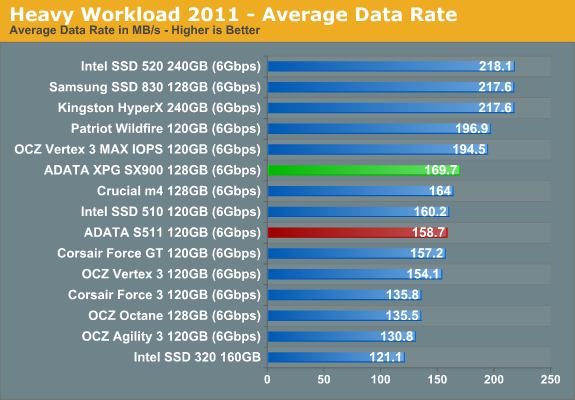
The SX900 is slightly faster than the Vertex 3 and Force GT here, which is most likely due to the newer firmware as I noted in the incompressible sequential read/write speed section. I asked Anand to test a 120GB ADATA S511, which is based on the same SF-2281 controller and utilizes 25nm Intel MLC NAND. The SX900 and S511 should be as similar as possible; however, they don't share the same firmware version. The SX900 is reported to have firmware version 5.0.1 in Device Manager, whereas the S511 Anand tested was running 3.2.2. That's the most current firmware for the S511 and it dates back to November 2011, so this is likely the reason for the difference in performance.
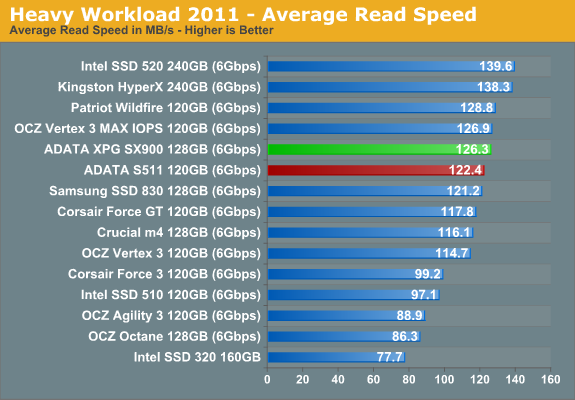
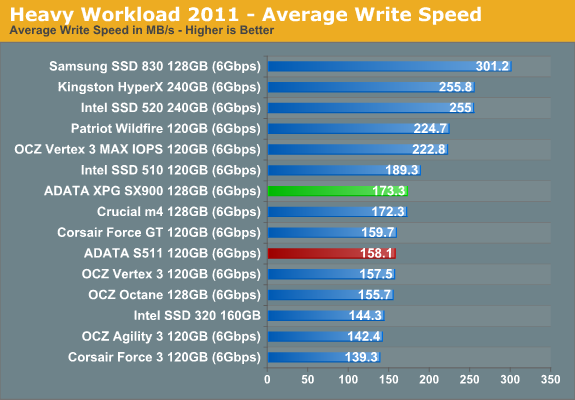
The next three charts just represent the same data, but in a different manner. Instead of looking at average data rate, we're looking at how long the disk was busy for during this entire test. Note that disk busy time excludes any and all idles, this is just how long the SSD was busy doing something:
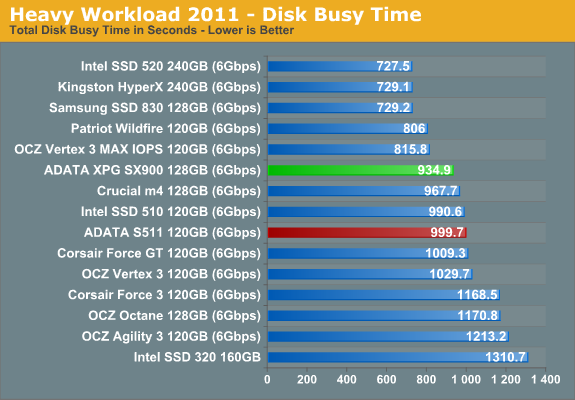
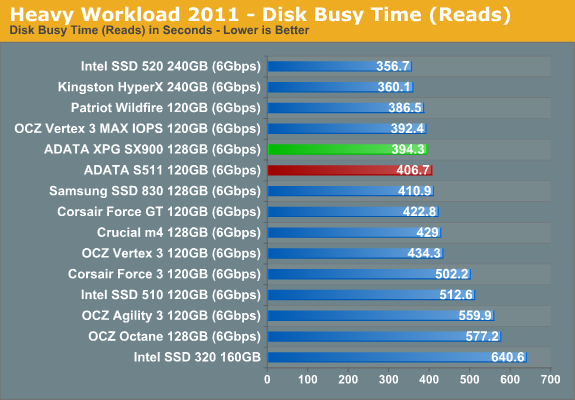
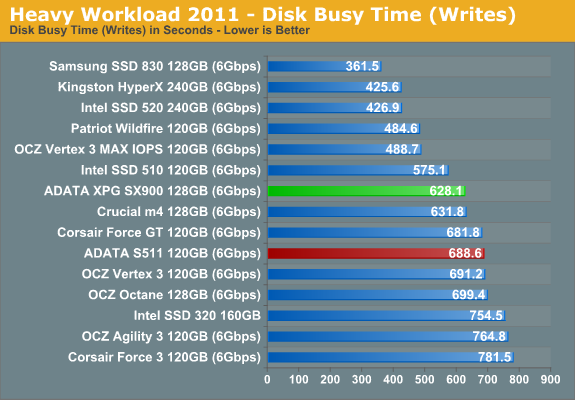










58 Comments
View All Comments
XZerg - Friday, June 8, 2012 - link
But at least include Mushkin in the benches, after all that's the cheapest SSD out there. This would give a better picture of $/performance.Kristian Vättö - Friday, June 8, 2012 - link
We don't have any Mushkin drives in our labs. I have asked Mushkin for a review sample but I have yet to receive a reply.CeriseCogburn - Monday, June 11, 2012 - link
I hate to say it but "good !" - that's what keeps their asynchonus prices so low. :-)Belard - Friday, June 8, 2012 - link
Considering the history and being a favorite, I think the Intel X25-M G2 120GB should be included in the benchmarks. So many of us can track the improvements and see if its a good time to upgrade or not.The G2 still does pretty good for its slow-interface, since its not a SF drive.
Kristian Vättö - Friday, June 8, 2012 - link
Bench also works :-)http://www.anandtech.com/bench/Product/605?vs=126
Belard - Monday, June 11, 2012 - link
Thanks... Its still easy to forget that function is on the website.Assimilator87 - Friday, June 8, 2012 - link
There's no point in including more than two, MAYBE three SandForce drives. One with synchronous NAND, one with asynchronous, and the Intel cuz it has a different firmware. They're all the same hardware with a different sticker.iceman98343 - Friday, June 8, 2012 - link
when are you going to rereview vertex 4? new fw was released.UltraTech79 - Friday, June 8, 2012 - link
Where are you guys getting these numbers? One place? The suggested retail price? The 256GB M4 is going for $0.70 per GB at amazon.Kristian Vättö - Friday, June 8, 2012 - link
We used DynamiteDeals to hunt for best deals. However, the table is a bit outdated (the prices are from May 22nd). I know it should be more up-to-date, but the problem is that DynamiteDeals does not work for me as it's tied to one's IP address. Since I'm located in Finland, it only finds Finnish stores (well, there is only one it finds...). Jarred made the pricing table but in the end, Anand was the one who posted this article (it's been ready for ages, just needed Anand's final look at it).